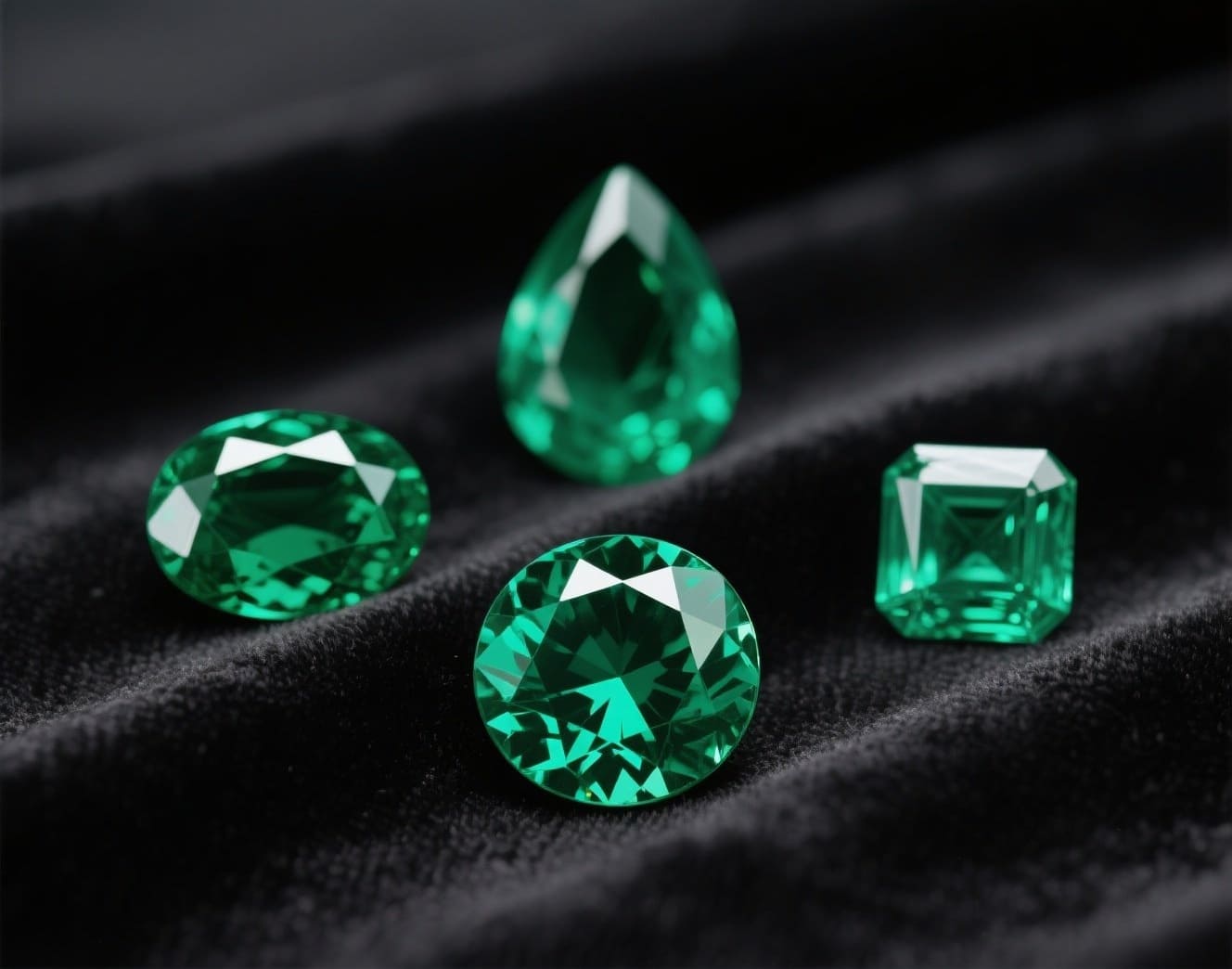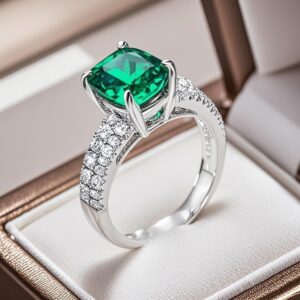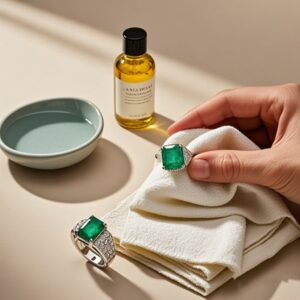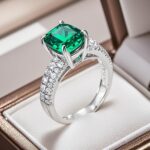Emerald jewelry has long held a special place in the world of luxury and symbolism. But with its radiant green hues and association with royalty and mysticism, one pressing question lingers for many potential buyers: Is emerald jewelry expensive? The answer depends on several factors, from the origin of the stone to the craftsmanship behind the final piece. In this in-depth guide, we’ll break down what contributes to the cost of emerald jewelry, the journey from raw gemstone to elegant accessory, and how meaning, materials, and design intersect to determine value.
The Origins: Where Do Emeralds Come From?
The journey of any emerald jewelry piece begins deep within the Earth. Emeralds, a variety of the mineral beryl, derive their vivid green color from trace amounts of chromium and vanadium. The most prized emeralds historically come from Colombia—particularly from the Muzo, Coscuez, and Chivor mines—where the stones are renowned for their pure, saturated green and excellent clarity. Other notable sources include Zambia, Brazil, Ethiopia, and Afghanistan.
Colombian emeralds often fetch the highest prices due to their rarity and depth of color. Zambian emeralds, on the other hand, tend to have a bluish-green hue and are often cleaner, which may appeal to buyers looking for greater clarity at a slightly more affordable price.
From Rough to Radiance: The Craft of Cutting Emeralds
Emeralds are notoriously difficult to cut. Unlike diamonds, which rank a perfect 10 on the Mohs hardness scale, emeralds score a 7.5 to 8 and have what’s known as “perfect cleavage,” making them more prone to chipping. As a result, skilled lapidaries often use the emerald cut—a rectangular step cut with cropped corners designed to reduce stress on the gem while enhancing its natural brilliance.
This precision and care increase labor costs, particularly for real emerald jewelry that features large, high-quality stones. Unlike diamonds, which rely on brilliance and sparkle, emeralds are valued for their color, and cutting must preserve this above all else.
The Role of Treatments: Natural vs. Treated vs. Lab-Grown Emeralds
Most natural emeralds have some form of internal flaw, known as “jardins” (French for gardens), which are considered part of their character. However, these inclusions often require enhancement through oiling—a standard industry practice that improves clarity by filling fractures with cedarwood oil or other resins.
It’s crucial to distinguish between natural emerald jewelry, lab grown emerald jewelry, and treated gems when assessing value. Natural, untreated emeralds are the rarest and most expensive, while lab grown emerald jewelry—though chemically identical—is more affordable due to its controlled production and fewer imperfections.
Design, Setting, and Metal: How Craftsmanship Affects Cost
The stone itself is only one part of what makes emerald jewelry expensive. The design and materials used in the setting are equally important. Custom-designed pieces, especially from renowned artisans or brands, can significantly increase value. For example, a real emerald jewelry set designed by a master jeweler using high-karat gold or platinum will cost far more than a simple commercial design.
The choice of metal also plays a key role. Gold and emerald jewelry is timeless and often seen as the most traditional pairing, while platinum and emerald jewelry exudes a cooler, modern elegance. For those seeking a more affordable option, silver and emerald jewelry offers beauty at a lower price point, though it may not age as well or hold value over time.
Emerald Jewelry and Symbolism: More Than Just Beauty
What makes emerald jewelry even more compelling is its rich symbolism and cultural resonance. For centuries, emeralds have been seen as a symbol of rebirth, fertility, and eternal youth. In ancient Egypt, Cleopatra was famously obsessed with emeralds, associating them with protection and immortality. In Vedic astrology and various faiths, emeralds are linked to the heart chakra and Mercury, said to promote wisdom, harmony, and emotional healing.
This deeper meaning adds intrinsic value to emerald gemstone jewelry, especially for those who choose it not just for aesthetic reasons but also spiritual or symbolic ones. In modern metaphysical circles, emerald crystal jewelry is believed to enhance intuition and emotional clarity—attributes highly sought after in times of uncertainty.
Styles, Trends, and Pairings: Modern Takes on a Classic Stone
Today’s emerald jewelry comes in an astounding variety of styles and settings. From bold cocktail rings to minimalist pendants and vintage-inspired earrings, there’s something for every taste. Pairings with other stones are also trending: think emerald and diamond jewelry for timeless luxury, or bolder combinations like emerald and ruby jewelry or emerald and sapphire jewelry for color-rich contrast.
Emerald cut diamond jewelry, which features diamonds shaped in the same step-cut style as emeralds, is also on the rise for engagement rings. These cuts highlight the clarity and structure of the gem, making them ideal for those who appreciate refined elegance.
Style Evolution: From Ancient Royalty to Contemporary Chic
Emerald jewelry has evolved dramatically from the ornate crowns of monarchs to the minimalist aesthetics of modern design. In ancient Persia, India, and Byzantium, emeralds were worn by kings, queens, and high priests to symbolize divine right and inner wisdom. These early pieces were often elaborate and embedded in ceremonial armor, daggers, and tiaras.
During the Art Deco era of the 1920s and 1930s, emeralds found a new home in geometrically inspired, platinum-set pieces. This period marked the rise of emerald cut jewelry, which suited the architectural lines of the time. Today, the Art Deco revival continues to influence everything from engagement rings to statement earrings.
In the 21st century, genuine emerald jewelry has embraced both tradition and innovation. Brands are blending vintage motifs with modern shapes—think asymmetric designs, negative space, and mixed materials. This allows emeralds to shine not just in gala settings, but also in everyday wear.
Famous Emerald Jewelry: Iconic Pieces and Their Legacy
The allure of emeralds is magnified when worn by celebrities and royals. One of the most iconic examples is Elizabeth Taylor’s Colombian emerald and diamond jewelry set by Bulgari. Her pendant brooch alone sold for over $6.5 million at auction in 2011, demonstrating the timeless prestige and investment value of top-quality emerald pieces.
Other legendary emerald wearers include Jackie Kennedy, who received an emerald cut diamond jewelry engagement ring, and Princess Diana, who often wore emerald and pearl jewelry during formal events. More recently, celebrities like Angelina Jolie, Beyoncé, and Zoe Kravitz have flaunted custom emerald earrings and necklaces on red carpets, reaffirming the gem’s fashionable status.
Whether vintage or contemporary, famous emerald jewelry often sets trends and shapes consumer expectations. These high-profile appearances also raise awareness of quality, rarity, and the value behind emerald-centric pieces.
Stone Combinations: When Emerald Meets Other Gems
Emeralds often play beautifully with other gemstones, creating striking visual contrasts and thematic pairings. Among the most captivating combinations are:
- Ruby and emerald jewelry – Red and green offer a bold, regal contrast, often used in traditional Indian bridal sets or festive holiday designs.
- Amethyst and emerald jewelry – The combination of deep purple and vibrant green is luxurious and slightly mysterious, favored in avant-garde styles.
- Opal and emerald jewelry – The iridescent play-of-color in opals complements the velvety depth of emeralds, ideal for ethereal and whimsical designs.
- Aquamarine and emerald jewelry – With both gems belonging to the beryl family, this duo exudes cool-toned elegance perfect for spring and summer styles.
- Garnet and emerald jewelry – A romantic, vintage-inspired combination often seen in Victorian or Gothic jewelry.
These pairings elevate the artistic expression of emerald jewelry and provide a richer, more personal statement.
Real vs. Fake: How to Identify Authentic Emerald Jewelry
Given the high value of genuine emeralds, the market has seen its fair share of fakes and simulants. If you’re considering investing in real emerald jewelry, here are a few key things to watch out for:
- Inclusions: Natural emeralds usually have internal inclusions, or “jardins.” If a stone looks too perfect, it could be synthetic or glass-filled.
- Color Consistency: Real emeralds often have slight color zoning or variations; lab-created stones tend to be uniformly colored.
- Heat Conductivity Test: Emeralds have low thermal conductivity. Jewelers often use a gem tester to measure this.
- Professional Certification: Always request a certificate from a reputable gemological lab like GIA or IGI when buying high-value emerald gemstone jewelry.
By knowing what to look for, buyers can ensure they’re purchasing authentic, high-quality stones that retain both aesthetic and investment value.
Care and Maintenance: How to Clean and Preserve Emerald Jewelry
Emeralds are softer than many other gemstones, which makes proper care essential to maintaining their beauty. Here’s how to clean and store your emerald jewelry safely:
- Avoid ultrasonic cleaners: These can damage the internal structure of emeralds, especially if they’ve been oiled or filled.
- Use mild soap and lukewarm water: Gently clean your piece with a soft cloth or brush. Avoid soaking it for too long.
- Keep away from heat and chemicals: Prolonged exposure to sunlight, high temperatures, or harsh cleaning agents can degrade the stone or the setting.
- Store separately: Use a soft pouch or jewelry box to avoid scratches from harder gems like diamonds or sapphires.
If you’re wondering how to clean emerald jewelry at home, this low-pressure method will help you maintain its luster without risking damage.
Irish and Spiritual Connections: Emeralds in Culture and Belief
Emeralds are often associated with Ireland—the “Emerald Isle”—due to the country’s lush green landscapes. As a result, Irish emerald jewelry has become a popular genre, especially for Celtic-inspired pieces like Claddagh rings or Trinity knot pendants. These often combine emeralds with gold and intricate knotwork to symbolize love, loyalty, and eternity.
Spiritually, emeralds are connected to the heart chakra, which governs compassion, forgiveness, and emotional openness. Many believe that wearing emerald crystal jewelry can help attract love, restore internal harmony, and aid in recovery from heartbreak. Whether or not you subscribe to metaphysical beliefs, the emotional resonance of emeralds undeniably adds depth to their appeal.
Emerald Birthstone Jewelry: A Gift with Meaning
Emerald is the birthstone for May, making emerald birthstone jewelry an ideal birthday gift. It’s also commonly used in 20th and 55th wedding anniversaries, symbolizing enduring love and renewal.
Giving an emerald piece to someone born in May or during significant life milestones adds emotional significance and personal connection to the jewelry. Whether it’s a minimalist pendant or a real emerald jewelry set, the gift carries both beauty and sentiment.
Why Is Emerald Jewelry So Expensive? A Breakdown of Pricing Factors
Emerald jewelry is often priced at a premium compared to other colored gemstones. But why exactly is that the case? Here’s a breakdown of the major factors that contribute to its cost:
1. Source and Rarity
The finest emeralds come from Colombia, Zambia, and Brazil. Colombian emeralds are especially prized for their pure green color and minimal bluish undertones.
These high-quality stones are rare, and rarity always drives price. Zambian emeralds, though slightly bluish, are often cleaner and more affordable alternatives—but still valuable.
2. Inclusion Tolerance
Unlike diamonds, emeralds are expected to have inclusions. Gem-quality emeralds that are transparent with a rich color and minimal visible inclusions are extremely rare—and extremely expensive.
This rarity gives them a market advantage over more “perfect-looking” but synthetic or lab-grown counterparts.
3. Enhancements and Treatments
Most emeralds are treated with oils or resins to improve clarity. Untreated stones—particularly if they are from a well-known mine—can fetch up to three times the price of a treated equivalent.
Natural emerald jewelry made with untreated gems is rare and highly collectible.
4. Craftsmanship and Setting
Emeralds are notoriously brittle, which means cutting and setting them require a high level of skill.
This fragility increases labor costs, especially for custom-designed pieces. Gold, platinum and emerald jewelry, or emerald and diamond jewelry often demands premium prices due to the complexity of balancing durability with visual appeal.
5. Brand Influence
Designer and luxury brands like Cartier, Tiffany & Co., and Chopard sell real emerald jewelry at significantly higher prices, not just for quality but for prestige.
Branded jewelry often includes certification, exclusivity, and heritage—intangibles that add to the total cost.
Is Emerald Jewelry a Good Investment?
So, is emerald jewelry worth the price tag? The answer depends on your purpose.
As a Collector’s Item
High-quality, untreated emeralds from reputable mines (like Muzo in Colombia) have consistently appreciated over time. Real emerald jewelry sets, particularly antique or vintage pieces, can increase in value if properly preserved and documented. This makes them viable options for collectors and investors alike.
As a Heirloom
Emeralds are deeply symbolic and emotionally rich. Passing down a genuine emerald jewelry piece through generations adds family history and sentimental value. While it may not be liquid cash, it becomes a meaningful part of your legacy.
As a Fashion Asset
If you’re not buying for resale but for occasional wear, lab grown emerald jewelry offers affordability and similar visual appeal. However, these stones do not carry the same investment potential or mystique as natural emeralds.
Investment Tip:
Always get appraisal certificates and consider insuring your emerald gemstone jewelry if its value exceeds a few thousand dollars.
Buying Emerald Jewelry: What You Need to Know
If you’re planning to buy emerald jewelry, especially online, here are some essential tips:
1. Understand the Four Cs (Plus One)
- Color: The most important factor. Look for vivid green with medium to dark saturation.
- Clarity: Expect inclusions, but avoid stones that appear cloudy or cracked.
- Cut: Emerald cut jewelry enhances the stone’s depth while protecting its corners.
- Carat: Larger stones increase value, but quality trumps size.
- Certification: Always request documentation from labs like GIA or IGI.
2. Choose the Right Metal
- Gold and emerald jewelry is warm, traditional, and romantic.
- Silver and emerald jewelry offers a cool, contemporary look—great for younger buyers.
- Platinum and emerald jewelry combines strength and prestige, ideal for heirloom pieces.
3. Assess Your Purpose
- For daily wear, choose bezel or halo settings that protect the gem.
- For special occasions, allow for more extravagant, exposed cuts.
- For gifting, emerald birthstone jewelry is always meaningful and elegant.
4. Research the Seller
Look for transparency in sourcing, return policies, and customer reviews. Don’t hesitate to ask where the emerald was mined, how it was treated, and whether it’s synthetic or natural.
Conclusion: Is Emerald Jewelry Worth the Price?
So, is emerald jewelry expensive? Yes—but for good reason. From their geological rarity to their complex symbolism, emeralds occupy a unique position in the world of gemstones. Their pricing reflects not just the stone itself, but centuries of history, belief systems, artisanal craftsmanship, and market demand.
Whether you’re a seasoned collector, a first-time buyer, or someone seeking a meaningful gift, emerald jewelry offers a rich return—not only in value, but in cultural and emotional resonance.
The real question isn’t “Why is emerald jewelry expensive?” but rather: What is it worth to you?
If you value beauty, rarity, and story, there may be no gemstone that delivers more.






